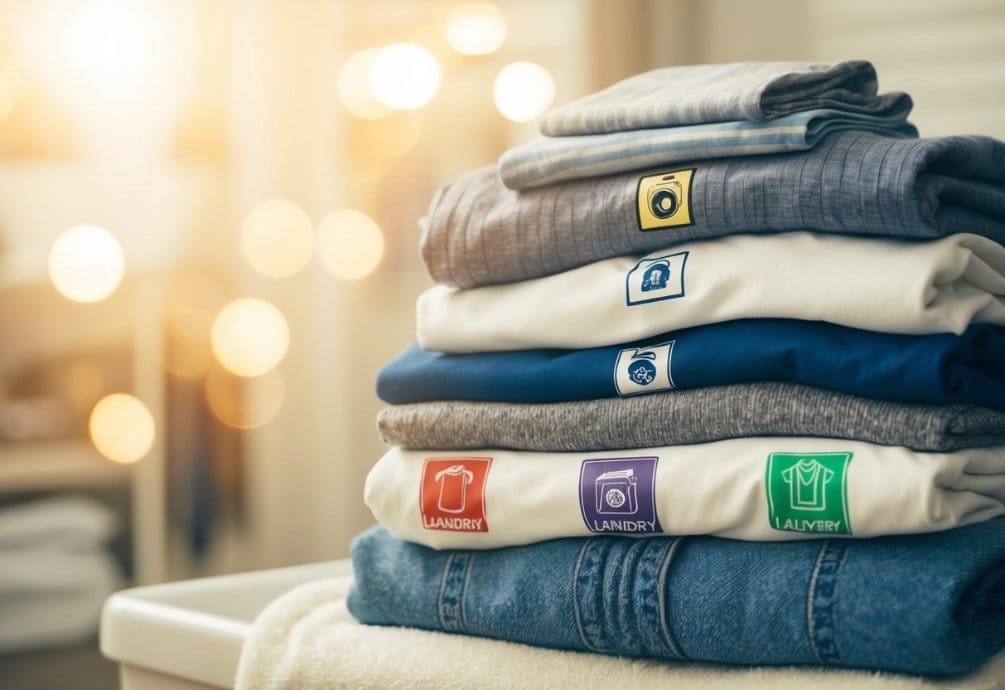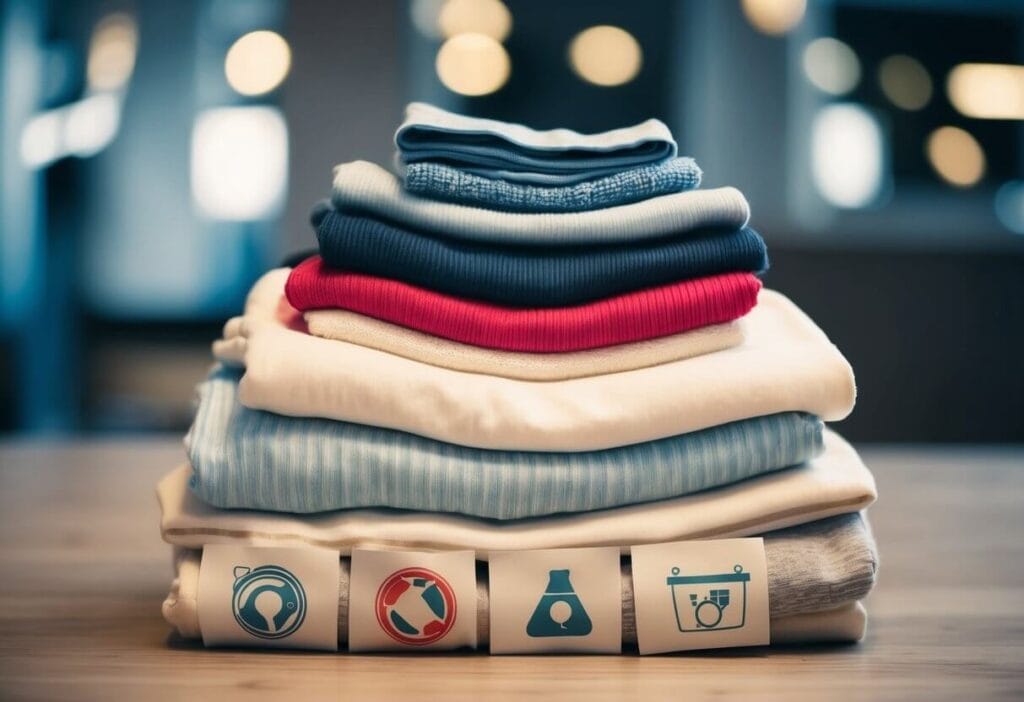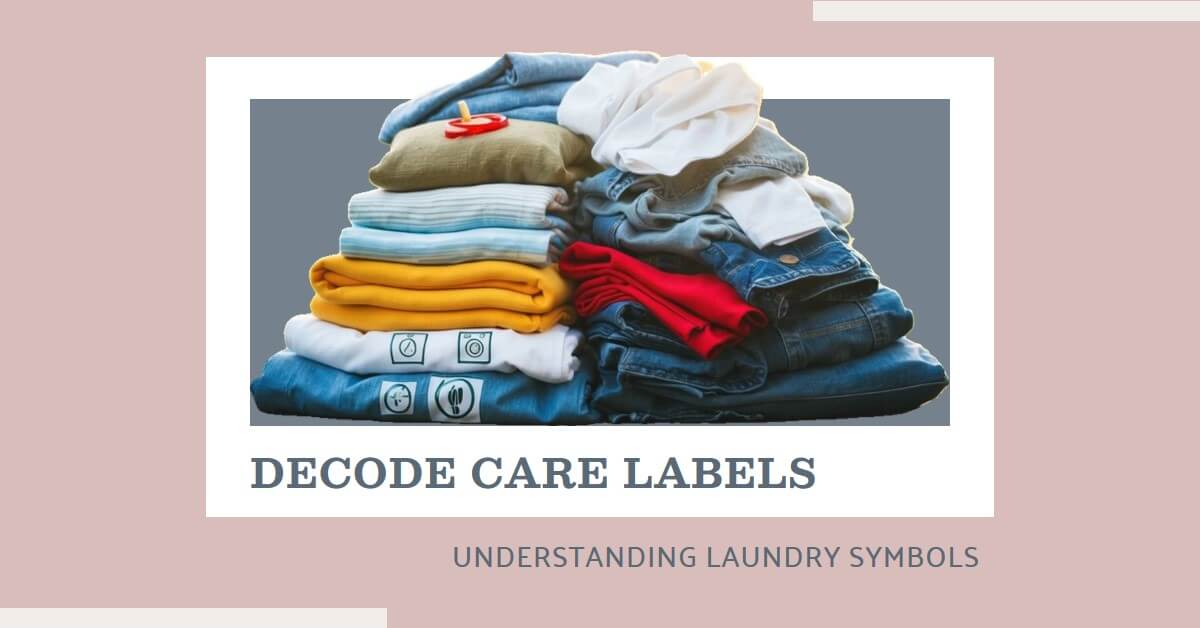Laundry symbols can seem confusing at first, but they play a crucial role in keeping our clothes in great shape. Knowing what these symbols mean can help you wash, dry, and care for your garments correctly, avoiding damage and extending their life. By learning to decode these symbols, you can make laundry day less of a chore and more of a breeze.
From the washing instructions to care tips for drying and ironing, understanding laundry symbols ensures that I treat each garment correctly. For example, specific symbols may indicate whether an item should be machine washed or hand washed, dried flat, or ironed on a low setting. When I follow these symbols, it not only preserves the quality of my clothes but also saves me time and money.
Familiarizing myself with these symbols allows me to take charge of my laundry routine. With a little practice, I can confidently tackle my laundry while keeping my clothes looking their best.
Table of Contents
Key Takeaways
- Laundry symbols provide essential care instructions for your clothes.
- Understanding these symbols helps prevent damage when washing and drying.
- Following care tips can extend the life of your garments.
Understanding Laundry Symbols

Laundry symbols found on care labels are essential for proper garment care. These symbols provide specific instructions on how to wash, dry, iron, and bleach clothing. Knowing these symbols helps me keep my clothes in great shape and can save them from damage. Below are the key symbols to understand.
Decoding Washing Symbols
When I look at washing symbols, the first thing I check is the bucket icon. It indicates the washing instructions.
- Water Temperature: A number inside the bucket tells the maximum water temperature.
- Hand Wash: A hand in the water symbol means to wash by hand.
- Machine Wash: The absence of a hand means machine washing is acceptable.
Other lines under the bucket give me more details. One line indicates a permanent press cycle, while two lines refer to a gentle cycle. If I see an X over the bucket, that means I shouldn’t wash the item at all.
Interpreting Drying Symbols
Drying symbols help me know how to dry my clothes after washing. The basic shape is a square, with different symbols inside to specify the method.
- Circle: If there’s a circle inside the square, it tells me to tumble dry.
- One dot means low heat.
- Two dots mean medium heat.
- Drip Dry: A square with three vertical lines means to let it drip dry.
- Lay Flat: One horizontal line at the bottom of the square means to lay the item flat to dry.
If there are curved lines at the top, that means I should hang the item to dry.
Ironing Symbols Explained
To avoid damaging my clothes, I pay attention to ironing symbols. An iron icon indicates whether and how to iron the garment.
- Dots Inside the Iron: Dots indicate the heat level:
- One dot: Low heat.
- Two dots: Medium heat.
- Three dots: High heat.
If there is an X over the iron, I shouldn’t iron that item. This is important for fabrics that can melt or get damaged by heat.
Bleaching Symbols
Some garments allow the use of bleach, and the symbols indicate how to do that safely.
- Triangle: This symbol means bleach may be used.
- An empty triangle means any bleach is fine.
- A triangle with an X means no bleach at all.
Knowing these symbols prevents me from accidentally ruining clothes. If unsure, I can always refer to a laundry symbols guide for clarification. These instructions help preserve the life of my clothing and maintain its appearance.
Washing Clothes

When it comes to washing clothes, knowing the right methods and settings can make a big difference. I’ll cover how to machine wash effectively, the best techniques for hand washing, and how to choose the proper water temperature.
Machine Wash Guidelines
Using a washing machine is convenient, but I must follow the symbols and settings on my garments. First, I check the care label to determine if an item can be machine washed. Common cycles include:
- Normal Cycle: For sturdy fabrics like cottons.
- Gentle Cycle: Suitable for delicate fabrics.
- Delicate Cycle: Best for items like lace or silk.
I also pay attention to load capacity and avoid overloading the machine. Using the right detergent, like Tide Pods, helps in cleaning without harshness. Always separate colors from whites to prevent color bleeding.
Hand Wash Techniques
For delicate items, I choose to hand wash. It’s simple and helps protect the fabric’s integrity. I fill a basin with lukewarm water and add a mild detergent. Here’s how I do it step-by-step:
- Dissolve Detergent: Mix it well in the water.
- Soak Garment: I gently submerge the item and let it soak for about 10-15 minutes.
- Gently Swish: I avoid scrubbing. Instead, I softly move the fabric in the water.
- Rinse: After washing, I rinse thoroughly under cold water to remove all soap.
This process minimizes wear and tear, allowing my clothes to last longer.
Choosing the Right Water Temperature
Water temperature plays a key role in cleaning clothes. I consider these options when washing:
- Cold Wash: Good for dark colors and delicate fabrics. It saves energy, too.
- Warm Wash: Effective for general loads without risking damage.
- Hot Wash: Best for whites and very dirty items but may cause shrinking.
I always refer to the care labels. Selecting the correct temperature can help maintain the clothes’ shape and color over time. Understanding these choices ensures my laundry routine is both effective and safe.
Drying and Ironing Clothing

Knowing how to dry and iron my clothes properly can make a big difference in keeping them looking their best. I will discuss the correct drying methods and how to iron different fabrics effectively.
Drying Clothes Appropriately
When drying clothes, I pay attention to the symbols on the care tags. Here are some common drying instructions you might see:
- Tumble Dry: This means I can use a dryer. If there’s a dot in the symbol, it shows the heat level: one dot for low heat, two for medium, and three for high heat.
- Drip Dry: This tells me to hang the clothes to dry without wringing them out.
- Line Dry: I hang my clothes on a line or hanger.
- Dry Flat: This instruction means to lay the item flat to dry, preventing stretching.
Understanding these symbols helps me avoid shrinking or damaging my clothes.
Ironing Techniques for Different Fabrics
Ironing is essential for keeping my clothes neat. Each fabric needs a different approach. The iron symbol on the care tag indicates what I should do:
- No Heat: For delicate fabrics like silk, I use no heat to avoid burns.
- Low Heat: Cotton blends can tolerate low heat, so I set my iron accordingly.
- Medium Heat: I use medium heat for most cotton and linen fabrics.
- High Heat: For heavy materials like denim, I set my iron to high heat.
Steam can also help remove wrinkles. I may lightly spray the fabric or use a steam setting to ease out tough wrinkles. Following these techniques ensures my clothes look fresh and well-cared for.
Special Care Instructions

Taking care of clothes often means following special symbols and instructions. Understanding these guidelines can help you maintain your garments and keep them looking new.
Handling Delicate Fabrics
When dealing with delicate fabrics, like silk or lace, I always check the care tags for specific instructions. Many delicate items come with a hand wash symbol, indicating that they should not go in a washing machine. Instead, I gently wash them in cool water with mild detergent.
If the care tag specifies “dry clean only,” I know it’s best to take it to a professional cleaner. Some items may also have “do not wring” symbols, which means I should avoid twisting or squeezing the fabric to prevent damage. Always lay delicate items flat to dry, away from direct sunlight, to avoid fading; look for symbols that indicate “dry in the shade.”
Strict Care Prohibitions
Certain laundry symbols clearly communicate what I should avoid. For instance, when I see “do not bleach,” I know that using bleach can ruin the fabric. If an item has a “do not tumble dry” symbol, I make sure to air dry it instead, either by hanging or laying it flat.
Additionally, I pay attention to “do not iron” instructions, as applying heat can damage some fabrics. If there’s a “do not dry clean” symbol, I avoid all types of dry cleaning treatments. These prohibitions are essential for preserving the quality and lifespan of clothing, so I always follow them closely.
Bleaching and Specialty Cleaning
Bleaching and specialty cleaning are essential parts of caring for clothes. Understanding the symbols associated with these processes can help me maintain my garments properly and avoid damage.
Understanding Bleaching Options
When it comes to bleaching, there are two main types: chlorine bleach and non-chlorine bleach. Chlorine bleach is effective for whitening whites and removing tough stains. However, it can damage some fabrics, so I must be careful.
Non-chlorine bleach, often marked with a triangle symbol, is a gentler option. It’s safe for colored fabrics and can help brighten colors without fading them. When the care label says “non-chlorine bleach only,” I know to avoid chlorine bleach entirely. Both options require a specific method of mixing with water and applying, so I always follow the instructions on the label.
Professional Cleaning Symbols
For garments that need special care, professional cleaning symbols guide me on how to proceed. The circle symbol indicates that a garment should be dry-cleaned. If there’s a “P” or “F” inside the circle, it tells me which type of solvent to use.
If I see a square with a circle but no letters inside, it means the item can be washed gently or dry-cleaned. I need to pay attention to these symbols to keep my clothes in good shape. Also, using the right laundry detergent is crucial, especially in delicate items, so I make sure to choose a product recommended for the care instructions.
Frequently Asked Questions
What are the symbols on a washing machine?
The symbols on washing machines typically include:
• A washtub with water temperature (30°, 40°, 60°, 95°)
• Spin cycle speeds (represented by lines under the tub)
• Special program icons (wool, delicate, eco)
• Rinse symbols (usually water drops)
• Drain symbols (arrow pointing down)
What are the symbols for washing conditions?
Washing conditions are shown through these basic symbols:
• 🔲 Basic tub symbol = machine washable
• ✋ Hand in tub = hand wash only
• ❌ Crossed-out tub = do not wash
• ♨️ Temperature settings
• ⚫ Dots for dryer heat
• 🔺 Bleach triangle
• ⬜ Square for drying
• ⭕ Circle for dry cleaning
• Lines under tub indicate agitation level: One line = gentle cycle
• Two lines = very gentle
• No lines = normal cycle
What is the 40 wash symbol?
The 40° symbol (tub with “40”) means:
• Machine wash at 40°C (104°F)
• Safe for most colorfast garments
• Standard temperature for colored clothes
• Suitable for cotton, polyester, and mixed fabrics
What is the P symbol in washing symbols?
The P symbol indicates:
• “Permanent Press” cycle
• Medium-heat washing and drying
• Reduced wrinkle cycle
• Commonly used for business casual clothes
• Often appears with one line under the tub
What do the symbols mean on my washing machine drawer?
Drawer compartment symbols indicate:
• I or ① = Pre-wash detergent
• II or ② = Main wash detergent
• ⚘ or ③ = Fabric softener
• Sometimes includes a “MAX” fill line
How do I check my washing symbols?
To check washing symbols:
1. Look at the care label (usually on inside seam)
2. Check both symbols and text instructions
3. Note temperature recommendations
4. Look for specific warnings (no bleach, dry clean only)
5. When in doubt, use cooler temperatures
What is the normal machine wash symbol?
The normal wash symbol is:
• Basic washtub symbol without lines
• May include temperature number• No special handling required
• Suitable for sturdy, colorfast fabrics
• Can use normal agitation
Which symbol is for fabric softener?
The fabric softener symbol looks like:
• ⚘ Flower symbol
• Sometimes shown as three vertical dots
• Located on rightmost drawer compartment
• May include “MAX” fill line
• Sometimes shown with wavy lines
Pro Tip: I always recommend taking a photo of the care label when you buy new clothes – they tend to fade over time, and having a digital record can save your favorite garments from laundry disasters!

